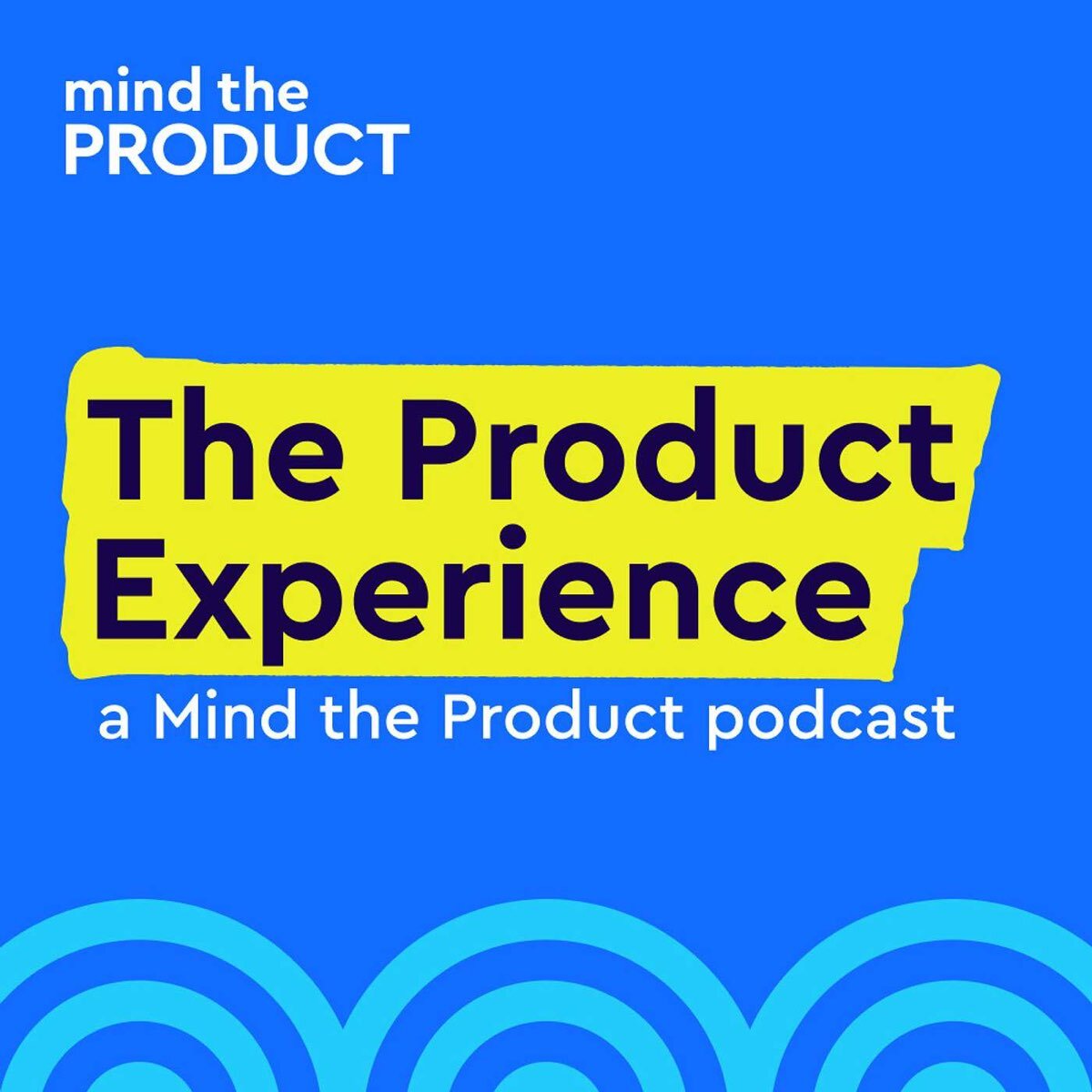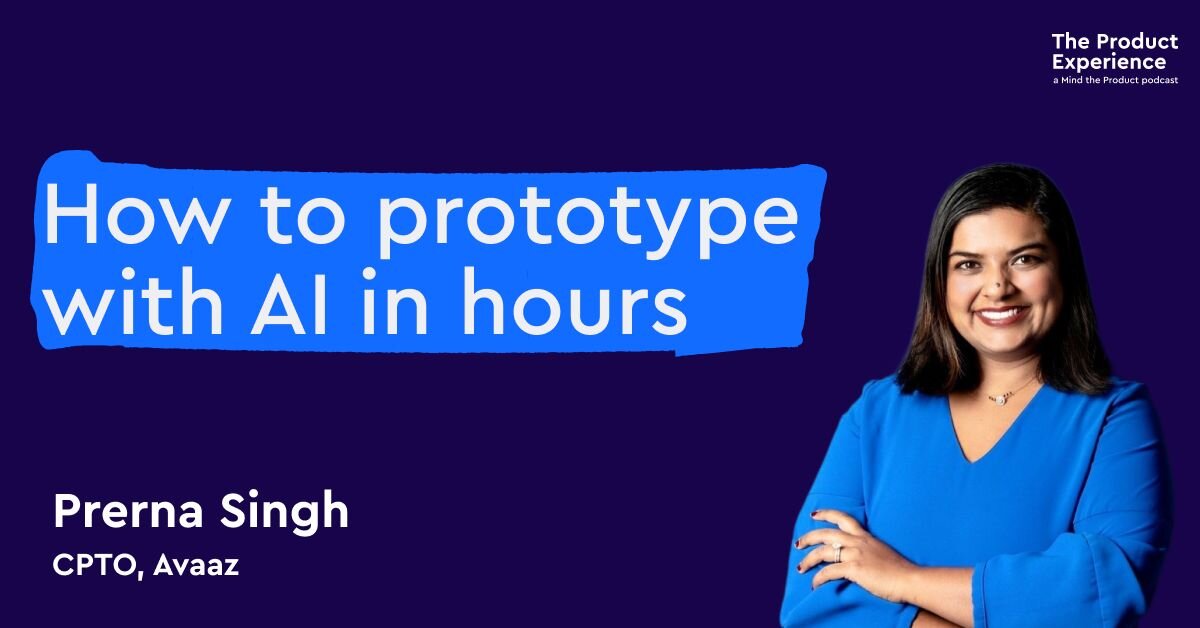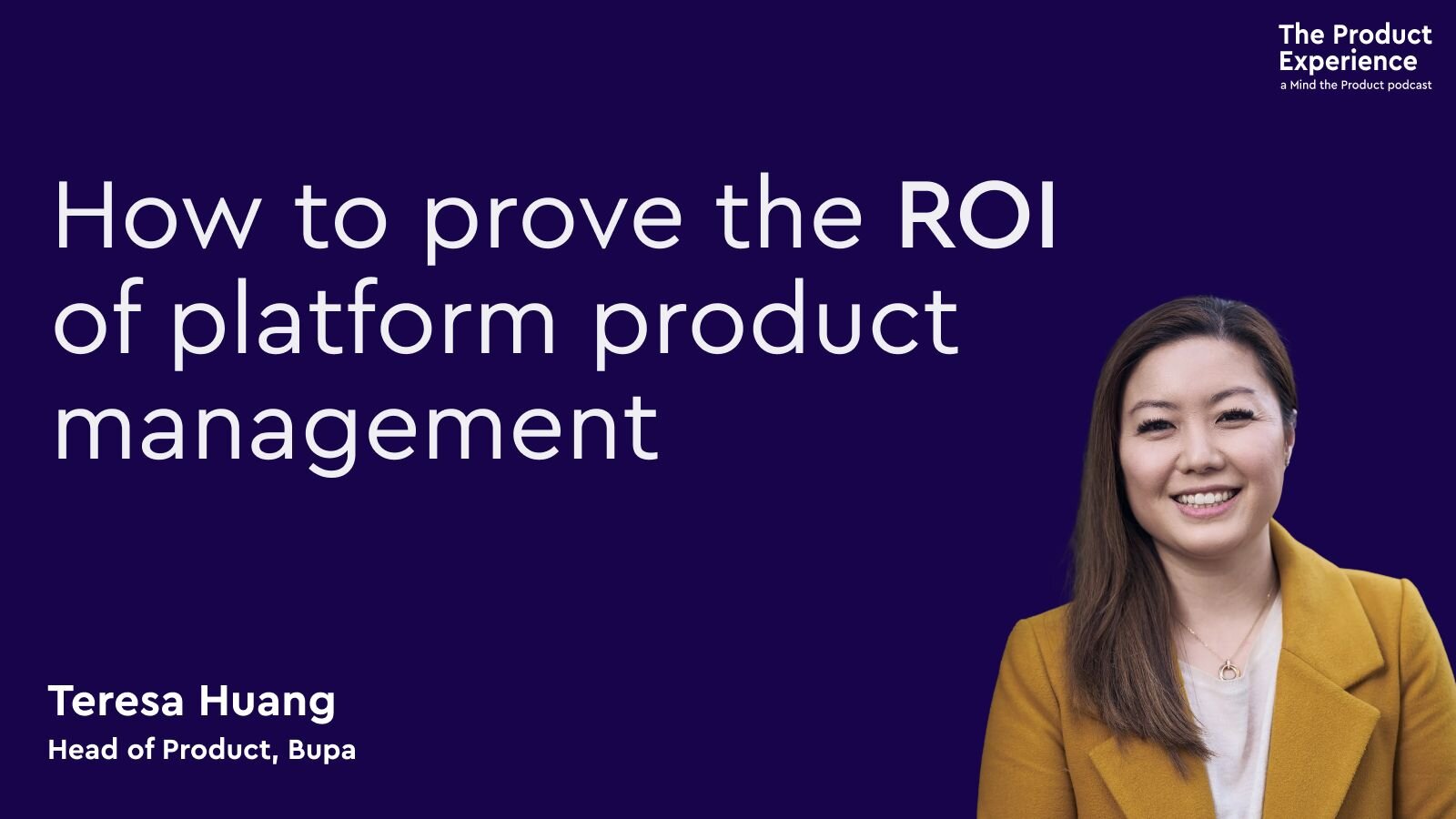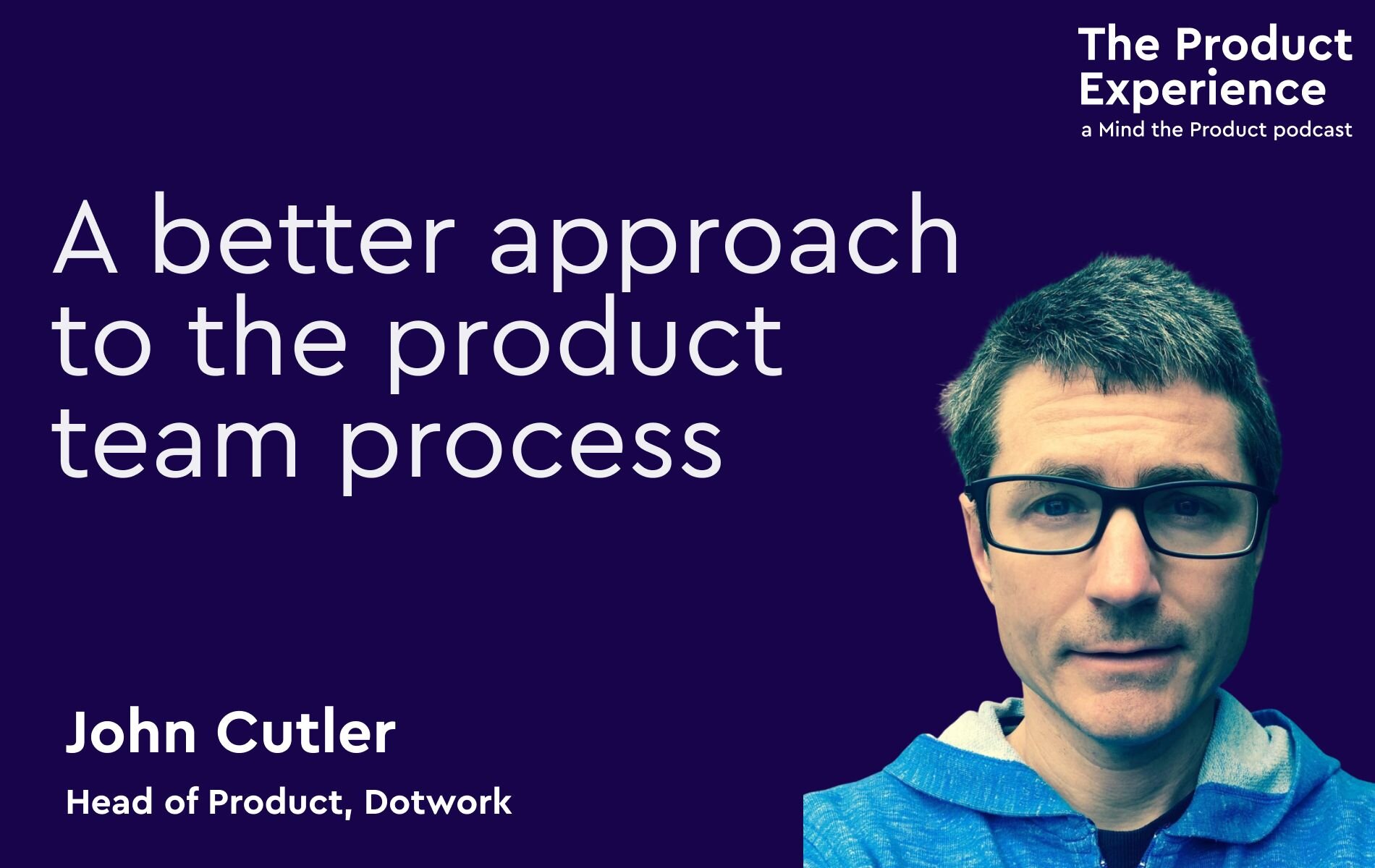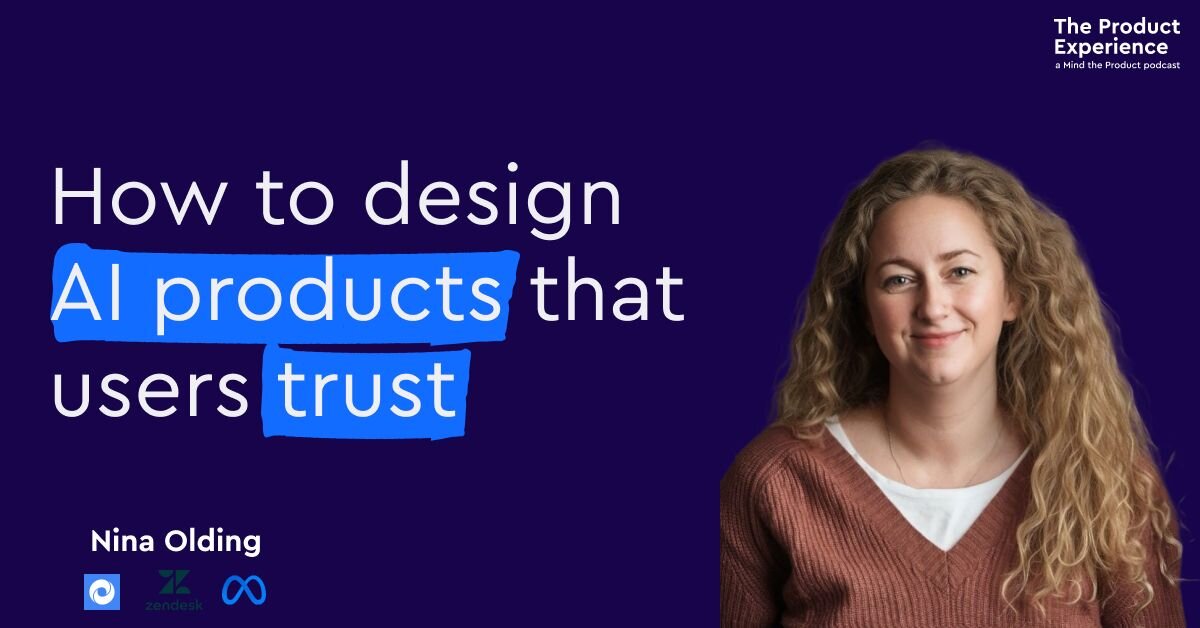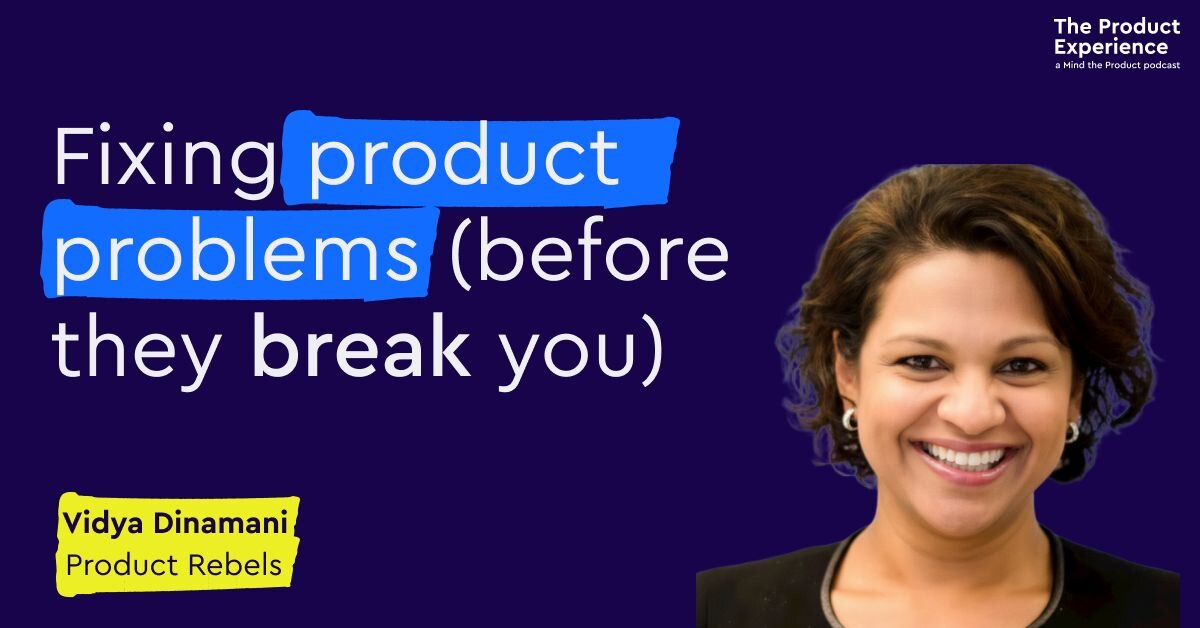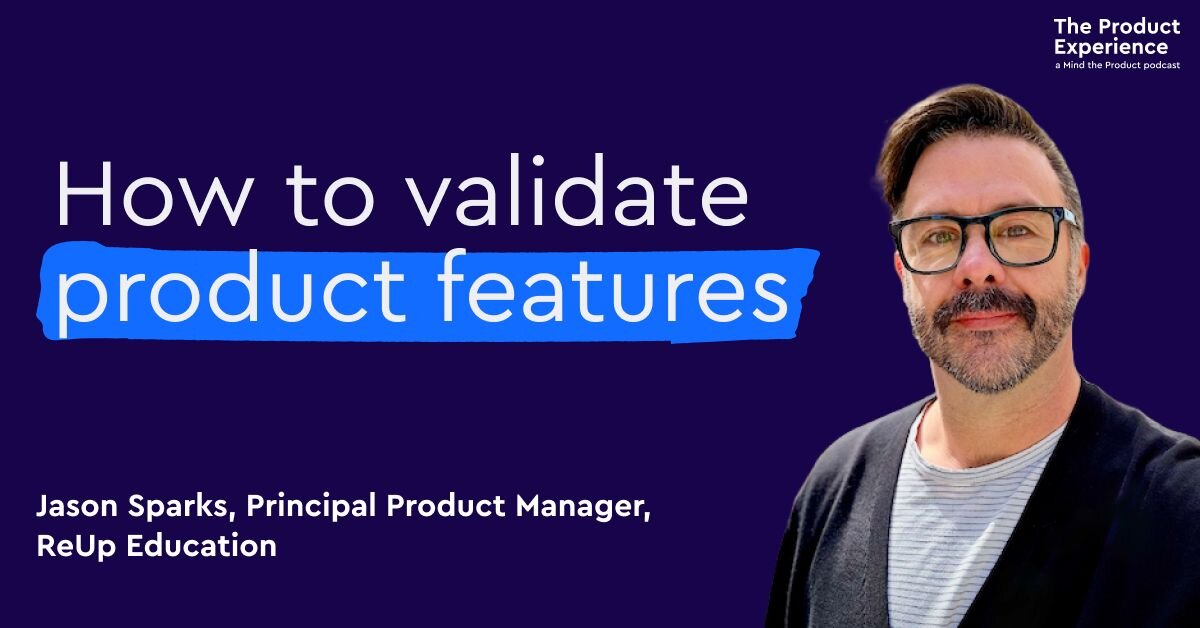Featured Links: Follow Kax on LinkedIn and Twitter | Kax's website | Women In Product | Kax's 'Coaching for Confident Product People' page
Episode transcript
Lily Smith (00:00):
Randy? Randy? I think he might still be hanging out with all those product celebs at the Product at Heart Conference in Hamburg, so I guess I'll just do this intro. Today we're going to be talking Kax Uson, head of product at Adevinta, and also she's a coach for Women in Product. She's telling us all about her journey from individual contributor all the way up to her leadership role that she currently holds. So without further ado, let's get straight to the chat.
(00:33)
The Product Experience is brought to you by Mind the Product. Every week on the podcast we talk to the best product people from around the globe. Visit mindtheproduct.com to catch up on past episodes and discover more.
Randy Silver (00:45):
Browse for free, or become a Mind the Product member to unlock premium content, discounts to our conferences around the world, and training opportunities. Mind the Product also offers free ProductTank meetups in more than 200 cities and there's probably one near you.
(00:59)
Kax, thank you so much for joining us on the podcast this week. How are you doing?
Kax Uson (01:07):
Very good. Thank you for inviting me over. It's super cool. I was pretty much telling my friends like, "Oh my God, I'm going to be in the Mind Product podcast." So this is my highlight of the week.
Randy Silver (01:18):
That's okay. We were telling our friends that, "Oh my God, we're going to have Kax."
Kax Uson (01:21):
Oh my God.
Randy Silver (01:22):
But for anyone who doesn't know who you are, can you just give us a quick intro? What are you doing these days and how did you get into the product world in the first place?
Kax Uson (01:32):
So hello everybody. My name is Kax, I am originally from the Philippines, but now I'm based in Barcelona. I moved here about eight years ago. I am a head of product for, and I say a head of product because there's a bunch of us heads of products in a company called the Adevinta. So we build marketplaces all over Europe. So I am the head of product for a tribe of around as of last count, 80 people. So it's a cross-functional tribe. Myself, I manage a team of 11 product managers and some of them managers themselves.
(02:10)
And well, I've been doing product management for around 10 years now, more or less, depending on which month I actually start counting from. But my path towards product management is a very, very, very common path. Accidentally. I got into product management, pure accident. I was working in a startup, I started out as employee number one, so it was just me and the CEO. And I was hired to be a project manager, a blanket title, which pretty much meant do everything there is to be done. So I was working with engineers, but the engineers were outsourced. I was customer service, I was dispatch manager because we were an e-commerce platform and some of the stocks were in our office, so I was also going to the front desk and delivering things for pickup.
(03:08)
So that was my role for the first few months. And then when we started hiring more people, of course I got more and more closer to the engineers. And when we were going through transformation for the startup, the name or the role of a project manager just didn't feel right anymore. And I was also starting to question like, "What is my path after this?" I like to work with the engineers, I like to define what was the next step for us, how we were going to change the platform. So project manager didn't feel right. So my CEO, my boss at that time, we literally went on Google, searched for, "What are the tech roles popular in Silicon Valley right now?"
(03:57)
Because it was 2012, probably in 2011, 2012, right about that time, and product managers did not exist in Philippines. Or if they were, they weren't so popular that nobody knew about them. So when we went on Google, searched for those roles, the product manager title came up, we were like, "Oh, this sounds nice, I like the ring of this, pretty much matches what I'm doing more or less. Let's go with that." And that was how I became a product manager.
Randy Silver (04:28):
Sounds like you're lucky that you didn't end up with the title Ninja or Rockstar.
Kax Uson (04:33):
It wasn't that popular then, I guess.
Randy Silver (04:37):
So we asked you to come on tape because you did a really great talk at the industry conference recently-
Kax Uson (04:44):
Thank you.
Randy Silver (04:44):
… talking about another thing you did accidentally, which was go from product individual contributor into the leadership role. How did that happen?
Kax Uson (04:54):
So I seem to end up in places randomly. So what I shared in my story then was that I was in a team, I was with a tribe, and I've been an individual contributor for most of my life. I thought I was just going to be an individual contributor forever because I did like the building things. However, my manager at that time, we were still a small team. I think we were around what? Five, six product managers in that team. My manager at that time was going to go on maternity leave, and I was the most senior person in the room, and at that time I was also starting to teach in a tech academy here in Barcelona. So there was already mentoring experience.
(05:44)
So she thought it made sense, I thought it made sense. So when she said, "Hey, I'm going to go, you take over." I just said yes because how do you say no to that very tempting proposition of, "Hey, you're going to be the product lead for the next couple of months, go forth and do the stuff"? So yeah, pure accident, because somebody had an idea, they thought it was good, I thought it was good. There was nobody else at that time that was more obvious than me, so I said, "Okay, cool. Let's do it."
Lily Smith (06:17):
So what were the expectations that you had in doing that role, and did you have any sort of reservations as well of, because you mentioned that you were thinking that you were on track to stay as an individual contributor. So was there anything that you were just not looking forward to or you thought you might have to do that you thought might not be enjoyable?
Kax Uson (06:41):
Well, my motivations were not very pure. I mean, when people say career growth, immediately you think up the ladder. Well, the most common notion is up the ladder. So for me, my motivation was to grow in my career by going up the ladder. So there was also the thinking of like, "Hey, this is going to be good for me, this is going to be good for my career if I take on this product lead assignment for the next couple of months." So that was motivation one. Motivation two I thought was, "Hey, product lead, I finally get to have a seat on the table, I can have influence under the session, my strategies will make sense," because before that I was doing strategies from an individual contributor perspective. It felt limited, I want to do more of that. So these were my understanding of what the product lead would be and that I have a team who would go forth and execute them.
(07:46)
I forgot the part of well, I have a team and I actually need to help my teams be successful, grow in their own careers themselves. I need to manage expectations, no longer just from my manager, but also from the people who are reporting to me and that they have their own feelings, different expectations. So those were the parts that I didn't really realise the moment that I said yes. And then the parts that this role would come with so many spreadsheets of budget and reporting, and all of those stuff. So those when they came, I was like, "Holy crap, what did I get myself into?" Suddenly from roadmaps to spreadsheet was my experience in the first few months especially. And the feelings. Many, many feelings.
Lily Smith (08:42):
So how did you navigate that initial experience? What were the first kind of couple of months like? How did you set yourself up? Because it's quite a shift, isn't it, going from being a member of the team to leading the team?
Kax Uson (08:56):
Yeah. So when I was sharing my story in industry, I actually had the miss… Well, not a miss, but more of like I had a very different view of what was going on. I thought I was being very good with my role because, well, what was happening. I promoted somebody, so there was a person in my team who got promoted two levels up, and I thought that this is the highlight of my career, I've gamed the promotion process, and I've helped somebody grow in their career as well. So cool, I'm the best product leader in the world. There was also an engineer who wanted to become a product manager, so I helped them make that shift and they were in my team. And once again, I was like, "Yay, me, people, careers, doing a great job."
(09:52)
And I also hired a new PM, so I thought this was what success looked like because I was doing these things, I was very, very good. But on the flip side, there were also bad things that were happening that I didn't realise were signs of my own failure. Like when I first joined, there was a new hire that my manager who left before her maternity leave, well higher than I was onboarding him. Three weeks later, this person left just at the end of his onboarding was like, "Oh, bye." We were getting so much negative feedback from the stakeholders and their expectations were not being met.
(10:35)
And between the teams themselves, there were conflict. But how I viewed these things were like, "Well, outside of my control, these are their people. The person who left, this is his decision factored by somebody." I didn't realise that I had also a hand in it like maybe the expectation was not correct or maybe, yeah, it was just a mismatch of opportunities where the conflict between teams, I thought like, "Okay, people are being petty, they're adults, they can take care of themselves." Not realising that I also had a hand in that because I was not giving correct expectations and people were conflicting with each other.
(11:17)
So these were my first months. I thought I was doing well until I actually got feedback from my manager who suddenly started asking me, "So when are you going to stop facilitating and actually leading? What kind of leader do you want to be?" And I really didn't understand what that feedback meant, took me months to actually go, "Ah, so that's what leading means." Because all I could think of was like, "Hey, what does this mean? I'm promoting people, I'm growing my team. People are happy because they got to change from engineer to product manager. What do you mean I'm facilitating? Isn't this my job?" But apparently the impact on the flip side was no, I wasn't doing my job.
Randy Silver (12:08):
How did that hit you when your manager said that, and what did you do next?
Kax Uson (12:13):
Well, I was in denial. I was like, "Yeah, but okay, this is a feedback." I was also in the sense feeling of, well, feedback is a gift from the sense of some feedback. If it's useful, you take it. If it's not useful, you throw it. But since I couldn't understand it, I set it aside. It sounded like it's important because it was coming from my interim manager, but because I didn't know what to do with it, I just set it aside. But it was also a very strange time in our organisation then, so I didn't really have enough time to sit with that feedback because suddenly there was a merger. So my team of four plus me and plus another person who wasn't reporting to me, grew doubled in size. So there were more problems coming in faster than I could process the reality that I already have problems.
(13:16)
And around the same time, my manager was coming back. So my motivation was more around, "I want to stay in this role, I want to keep doing this." And it was not about, "How do I become a better leader?" It's more like, "How can I continue and be a leader?" So it was not pure intentions either. So how did I process it? I didn't. I didn't until much, much later when the problems really exploded in my face.
Lily Smith (13:45):
Wow. I think it's really interesting when you get sort of feedback like that, and like you say, sometimes you don't know how to respond to it and you just kind of have to sit with it for a while. And then suddenly it'll kind of click, something else will happen, or there will be a moment where it's like, "Oh, that's what you meant when you said that thing. I didn't quite get, but it always just stuck in my head." I've definitely had moments like that.
(14:14)
And just thinking about managing that team through a merger as well, that must have been really quite a challenge, just managing a product team or leading a product team anyway is quite challenging. But then going through a merger, how did you navigate that from that sort of leadership position? Was it very much a case of just day by day tackling each fire as it arises? Or were you able to do any sort of really thoughtful, intentional leadership?
Kax Uson (14:48):
Not at all. I mean, at least not at the beginning. So before the merger, I was just in denial that there was something wrong with my leadership. I knew I was growing, but there was also a lack of self… I knew that I didn't have the tools yet, but there was also the lack of self-awareness that how my lack of tools was really impacting people. And then when the merger happened, it was not from a slow incoming wave of problems, it was a tsunami of problems, so my self-denial was no longer working. There were problems around, "Hey, we have duplicate products. What do we do with them?" I obviously didn't have the skills for that in the beginning like, "What do I do with this? This was not a problem I can run away from."
(15:39)
There were more complaints from the stakeholders because there was uncertainty, there was way too many things that we were not prioritising because we had another whole set of problems to think about, so it was just piling on top of each other. And my usual coping skills of, "Forget about the problem, deny that it exists, maybe it will go away," was not working anymore. So I had really no choice but to face those problems. And what I realised was that a lot of them were problems internally, so I was focusing on the wrong things. I was focusing on running away from the problems because I was conflict-averse. I was focusing on being liked by my team versus being very, or giving them guidance and clarity on things.
(16:34)
So when these problems started to happen, none of my usual, "Well, maybe I can be liked and maybe if they like me enough, their problems of duplicate products will go away." No, it didn't. It couldn't. So I needed to accept that I had a gap in my skill, I needed to do something about it. So that was my first step, awareness and acceptance that something needed to change, but it was not one of those from one day to another, "I'm aware, so I know what to do." It was actually a couple of more steps after in the sense of I decided to do something, but it was also an experimentation process of what that something meant.
(17:19)
So I went to the courses, I read the books, I watched all of the TED Talks, and I tried to apply different leadership principles and they still weren't working. When I tried to apply them, it was like conflicting solutions. So how do I involve the team but be decisive at the same time? When do I actually make the decision? How do I give autonomy but also give constraints? What does that mean? So then my team was just confused because they weren't really understanding what I wanted from them.
Lily Smith (18:10):
Hey, Randy, are the rumours true?
Randy Silver (18:13):
Lily, I can't believe it. MTP are giving away all nine of the San Francisco keynote talks for free, both a recording and a written summary of each one.
Lily Smith (18:23):
And handy discussion points and thought starters to think about solo or with your team.
Randy Silver (18:28):
And an email notification each time a new talk is published on mindtheproduct.com.
Lily Smith (18:33):
So you'll never miss a talk and be the first to hear when the next one is hot off the press.
Randy Silver (18:38):
Of course, nothing can beat attending MTP Con in person, but this is the next best thing.
Lily Smith (18:44):
So sign up at mindtheproduct.com/sfkeynotekit. That's mindtheproduct.com/sfkeynotekit.
Randy Silver (18:55):
Kax, I want to skip ahead a little bit. I'm sure we'll come back and talk about how you made the changes, but I'm curious, after hearing all this and now that you're reflecting on it, what's different in your practise now? What do you do? I'm sure you still have the same instincts around imposter syndrome or avoid avoidance and things like that, which we all have them in different ways, but what do you do in your day-to-day practise that's different than you were doing then?
Kax Uson (19:29):
So what I mentioned earlier, I focused on being liked. So my motivation was, "My team likes me," but it was not giving the positive results that we were expecting. So for me, it was a change of framing. So to put it mildly, I'm a people pleaser. That's pretty much the root of all my problems. But when I realised that it wasn't working, I had to reframe it. I couldn't really just kick off my people-pleasing tendencies like that one day to another. But I needed to frame it in a way that I am able to give hard feedback but not die inside because of my own feelings.
(20:15)
So for example, my framing then became, "Well, what is it actually that people need instead of what they want? What is their problem to solve and how can I help them solve it?" So that's one thing because if I think of it that way, my people-pleasing brain would probably go, "Well, if that problem is solved, maybe they would like me more." So I kind of weaponized my own limitations in that sense. So that helped, especially in the beginning, but then it became a habit more of like, "No, I really need to give this feedback." Yes, there's still that kick in my heart that hurts when I see faces turn from happy to upset, but then it becomes more of a normal thing of like, "This is a job I need to do. If I don't do this, we're all going to turn out bad."
(21:11)
And the other part is also distancing myself from other people's feelings because a lot of my limitation is really centred around how people think about me. Are they accepting me? So being able to distance people's feelings, not also trying to be too responsible of how their reactions, their decisions, their emotions, and focusing mostly on, "Okay, but what is the priority? What are the expectations that I need to give here? What is our goal? What are the things that we cannot change versus what are the things that are within our control?" And then if I focus on that, it's easier to accept that, "Well, people are not going to be happy today, tomorrow, maybe next week we're all right, but then it's not really on me to do something about their feelings."
Lily Smith (22:14):
And Kax, you're so kind of open about this, I find it really refreshing. You are really transparent about what you consider to be your limitations, although I'm sure-
Kax Uson (22:28):
There's more.
Lily Smith (22:29):
… could be strengths in other areas. Have you been like this with your team as well? I guess how have these conversations been with your team? Have you opened up to them about where you think you're failing and discussed that like in an open forum?
Kax Uson (22:49):
So I actually wasn't like this before. So again, going back to the people-pleasing problem, I don't want my team to think that I have issues. I want them to think that the sun shines out of my ass. I don't know if I'm allowed to say that, but there was one time, actually, somebody gave me feedback of like, "What are you really thinking? How are you really feeling? Show me some vulnerability here because you're so straightforward, you make things look so simple, but I'm not seeing that simplicity." So I think when that feedback came, it hit me that there's no harm in being upfront about how I'm feeling, how I'm processing things.
(23:36)
Of course, there are some things that I shouldn't share, I shouldn't be so upfront about, especially immediately, but the impact has actually been very positive with my team. And in a sense it has also helped me progress further because then I can bring my team along to my journey. So instead of telling them three steps after like, "Hey, this is what we're doing," I can bring them along like, "Hey, this is what I'm thinking. I'm not sure if this is going to work out, but hypothesis. Probably I'm adding noise right now, but if it works out, this is a good impact. If it doesn't work out, then nothing really bad happens, but I want you to know so you're not thinking that something hidden is happening in the background and you feel weird about it as well."
(24:29)
So it has helped me and it's been also a good thing to get good feedback that, "Hey, you are being transparent, you are normalising these things," has also helped me be more okay with my limitations, with the things that I don't know, and the struggles that I'm facing. So then I lean more into it because the impact has been good, so why not?
Randy Silver (24:57):
Kax, a couple minutes ago, you were talking about the fact that you read a bunch of books and you saw lots of talks, you were trying to figure out how to make the leap and get to the next level once you got the feedback. And now you're managing other people. I'm wondering, are there resources you give other people? Are there tools and books and things that you say, "This is what you need to do to acquire new knowledge to make the jump to leadership?" Or is it just, and I realise the word just is doing a lot of work here, but is it just a change in attitude?
Kax Uson (25:31):
I think it's a couple of things, so it depends on the person. So as a proper product manager, the answer is it depends. It depends as well first on the learning preference of the person, because I can give them titles and videos, etc., but their learning preference or actual learning skill is to do things hands-on, so maybe the best approach for them is to get into practise first. For some people, interactive learning is better, so then it's better to recommend workshops rather than books.
(26:05)
It also depends on the context of the person, what are their actual gaps and if they're aware of those gaps. So first there needs to be some acceptance that, "Hey, I need to work on this particular problem, or I want to work on this particular problem," before suggesting some things. Otherwise, I'm going to be listing down titles into the ether, but then it's not going to be used at all, so it really depends on the context of the person.
(26:35)
And then, to what you were saying as well, mindset. So if they don't want to change, if they don't want to grow, if they don't want to be in the leadership path either, then it's not that there's no point, maybe it's just not the time to suggest specific titles or books or something, but I'm going to start with learning preference because that was my problem. My learning preference is actually not books and videos, my preference is actually hands-on things. So probably that's why nothing of what I read stuck in my head.
Lily Smith (27:12):
So we kind of spoke really early on about frameworks and stuff, and you do actually have a bit of a back-to-basics framework or the framework that you applied in the end to your leadership journey. Tell us a bit about that.
Kax Uson (27:29):
Yeah. So when the books and the videos and the tips were not working for me, I went back to my basics of product management. So I put on my product manager hat and asked myself, "If this was a product to build, if this was an opportunity to take, what would I do actually?" And that's what I did. So I went back to my framework, my product management framework, which was have a vision or have a goal, define my problems to solve, what is my strategy then for these problems to solve and best actions to take? So what are the solutions to try? And then what was the impact and what did I learn?" So I can also look at it from an iterative perspective.
(28:22)
So a good example would be one problem to solve was we have duplicate products. What's my ideal situation? What's my vision? Well, we should not have duplicate products. So what then would be my strategy for this? So my strategy for this would be, well, what are the things that are getting in the way of getting rid of some of the duplicate products? While some of them are emotional, some of them we're not having clarity on what are the opportunities anyway. So if we get rid of one product, what were the teams going to do once they lose it? So there's just fear in there too. So there's that.
(29:06)
There's also, well, we have stakeholders who are so afraid of losing support because if we get rid of that product, it impacts some stakeholders. So what do we do about them? So just breaking down my problems or my situation into smaller problems, having a clear ideal scenario, and then understanding where can I act first was pretty much actually what worked for me. Probably there will be other frameworks there, but I think what's important is what will work for me, what will actually help me get into a state of action versus an analysis paralysis or going into a black hole of things that were clearly not solutions that I could try?
Randy Silver (29:54):
So one of the things you touched on there, and you've talked about a bit in the talk, was asking others for help and feedback. Yeah, I mean, for yourself and for your team as well. What was that like? What was the change in going from being an IC and how you dealt with stakeholders and peers to doing it as a leader?
Kax Uson (30:14):
Well, actually, even from an IC role, I never shied away from asking for help from my peers at least. I had very good relationships with my engineering counterparts, for example, for things. Simple things like, "Hey, I cannot do this presentation, can you?" So that was a normal thing for me. But when I moved to product leadership, I thought I shouldn't. That was my misconception at first like, "I should be the one providing this answer." But when I went back to my basics, I also went back to my basics of how do I actually do stuff? What were the things that were working for me before?
(31:01)
So then I started asking for help. At the same time, trying to do things by myself was also not working. I could keep doing things by myself and then have very little results. Or I could go back to my strengths, which was ask for help, and maybe the impact will be bigger. It was certainly worth a try. So for me, it was something to try. The feedback has been, or the impact has been pretty positive in the sense that people actually wanted to help. People were also invested in the situation. So they had their ideas, and it was a very welcome thing for them to receive that ask for help.
Lily Smith (31:47):
Kax, it's been so nice hearing about your journey, and thank you so much for sharing so openly. I just have one more question for you before we wrap. I'd love to know, having done the IC role and also now being in this leadership role, what's your own sort of vision for the future? Where are you headed?
Kax Uson (32:08):
Oh, that's a tough one. I think out of all of the questions, this is the toughest. So I am in a journey of experimentation. So one thing I know is that I really like this scope of helping people. I like the process of helping product managers, find answers for themselves versus me giving them answers all the time. I like helping product managers feel more comfortable and confident in their roles. So it's such a nice thing to see when product managers at the beginning were like, "Oh, no, I don't know all of the frameworks. I don't know how to do OKRs, I don't know how to do A, B, C, D, E." And then realise after like, "It doesn't really matter, just try something." And then they start to feel good, they start to enjoy the job again. So I want to do more of that.
(33:06)
In what shape or form? That is what I'm experimenting on. I enjoy the product leadership path, so I think for that, I will continue. There's also so many things for me to learn still as a product leader. I think the difference between being an IC and a product leader is that the growth is wider. In one year, two years, you can keep jumping from product manager to senior, to something, but as a product leader, the stretch is longer. So I will stay on this path for a bit or for as long as I can, or it makes sense. But I'm starting to also experiment more on the mentoring and the coaching, especially for aspiring for the leaders, those who want to make the leap but don't know how. Or for the new ones who, like me, the books weren't working for them. So that's the other experiment.
Lily Smith (34:02):
Awesome. Well, thank you so much for joining us. It's been so great talking to you.
Kax Uson (34:06):
Thank you. I enjoyed it as well.
Randy Silver (34:08):
Thanks, Kax.
Kax Uson (34:08):
Yay.
Lily Smith (34:08):
The Product Experience is the first-
Randy Silver (34:08):
And the best-
Lily Smith (34:26):
Podcast from Mind the Product. Our hosts are me, Lily Smith-
Randy Silver (34:31):
And me, Randy Silver.
Lily Smith (34:34):
Louron Pratt is our producer, and Luke Smith is our editor.
Randy Silver (34:37):
Our theme music is from Hamburg-based band PAU. That's PAU. Thanks to Arne Kittler who curates both ProductTank and MTP Engage in Hamburg, and who also plays bass in the band, for letting us use their music. You can connect with your local product community via ProductTank, regular free meetups in over 200 cities worldwide.
Lily Smith (34:58):
If there's not one near you, maybe you should think about starting one. To find out more, go to mindtheproduct.com/producttank.
